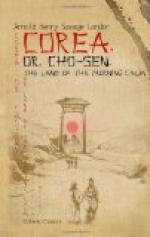The string is wound round a framework of wood attached to a stick, which latter revolves in the hands or is stopped at the will of the person who flies the kite. It is generally during the north winds that the kites are flown, and it is indeed a curious thing during those days to watch regular competitions, fights, and battles being fought among these paper air-farers. As soon as the kite is raised from the ground and started in the orthodox way, the tactics used by the Corean boy in his favourite amusement become most interesting. He lets it go until it has well caught the wind, and by sudden jerks given to it in a funny way, knocking and clapping the thread-wheel on his left knee, he manages to send the kite up to a very great height. Hundreds and hundreds of yards of string are often used. When high enough, sailing gaily along among hundreds of other kites, it is made to begin warlike tactics and attack its nearest neighbour. Here it is that the Corean shows his greatest skill in manoeuvring his flying machine, for by pulls, jerks, and twists of the string he manages to make his kite rise or descend, attack its enemy or retreat according to his wish. Then as you break your neck watching them, you see the two small squares of paper, hundreds of yards above you in mid-air, getting closer to one another, advancing and retreating, as would two men fighting a duel; when, suddenly, one takes the offensive, charges the other, and by a clever coup de main makes a rent in it, thus dooming it to a precipitous fall to the earth. Thus victorious, it proudly proceeds to attack its next neighbour, which is immediately made to respond to the challenge; but this time kite number three, whose leader has profited by the end of kite number two, keeps lower down than his adversary, gets round him in a clever way, and when the strings meet, by a hard pull cuts that of kite number one, which, swinging slowly in the air, and now and then revolving round itself in the air, gently descends far away from its owner, and is quickly appropriated by some poor kiteless child, who perhaps has been in company with many fellows, watching and pining for hours for such a happy moment. Pieces of broken glass are often tied to the string at intervals, being of great help in cutting the adversary’s cord.
The people of Cho-sen seem to take as much interest in kite-flying as the Britisher does in racing. The well-grown people bet freely on the combatants, and it is not an uncommon thing for the excitement to reach such a pitch that the battle begun in mid-air terminates with sound blows in less aerial regions.
It is quaint to see rows of children with their little red jackets, standing on the high walls of the city, spending hours in this favourite amusement. They have barely room to stand upon, as the wall is hardly more than a couple of feet wide, and it was always a surprise to me that, amid the constant jerking and pulling the young folks were never precipitated from their point of vantage to the foot, which in many places would be as much as thirty feet in height. I have watched them for hours in the expectation of seeing one of them have an accident, but unfortunately for me they never did!




